What'sNEW October-December 2012
 Evolution: A View from the 21st Century by James A. Shapiro is our new favorite book. The author writes from a challenging perspective gained from a thorough study of the variety of processes that manipulate genomes. These include, for example, DNA formatting, DNA proofreading and repair, and epigenetic regulation. He agrees that horizontal gene transfer (HGT) is important, although Shapiro deems "gene" an imprecise term and avoids it. Hence, Horizontal DNA Transfer. And he writes, ...Viruses serve as sources of novelties that can later be adapted by cells (p 133).
Evolution: A View from the 21st Century by James A. Shapiro is our new favorite book. The author writes from a challenging perspective gained from a thorough study of the variety of processes that manipulate genomes. These include, for example, DNA formatting, DNA proofreading and repair, and epigenetic regulation. He agrees that horizontal gene transfer (HGT) is important, although Shapiro deems "gene" an imprecise term and avoids it. Hence, Horizontal DNA Transfer. And he writes, ...Viruses serve as sources of novelties that can later be adapted by cells (p 133).
These processes plainly show that the genome is not a Read Only Memory (ROM) storage medium as traditional darwinism supposes, but a dynamic Read-Write (RW) system. He calls the collection of various processes that act on genomes Natural Genetic Engineering. The theory of evolution needs to incorporate these insights, he believes. We agree. Natural Genetic Engineering even sounds a lot like the software management systems that we think genomes must possess.
Shapiro does not go so far as to suggest that evolutionary advances require HGT in an open system, but we will not complain. He is shifting the paradigm in the right direction. The book has much to teach; we are still studying it.
| As to the actual nature of genetic change processes, you have seen... that cytogenetic observations, laboratory experiments, and, above all, molecular evidence about genomic sequence changes tell us that the simplifying assumptions made in the 19th and early 20th Centuries are plainly wrong (p 126). |
 James A. Shapiro, Evolution: A View from the 21st Century, FT Press Science, [publisher's promo], ISBN-10: 0132780933, 22 Jun 2011. James A. Shapiro, Evolution: A View from the 21st Century, FT Press Science, [publisher's promo], ISBN-10: 0132780933, 22 Jun 2011.
 James Shapiro: On The Evolution Paradigm Shift, interview with Suzan Mazur, Scoop, 6 May 2012.
Given the exemplary status of biological evolution, we can anticipate that a paradigm shift in our understanding of that subject will have repercussions far outside the life sciences.... James Shapiro: On The Evolution Paradigm Shift, interview with Suzan Mazur, Scoop, 6 May 2012.
Given the exemplary status of biological evolution, we can anticipate that a paradigm shift in our understanding of that subject will have repercussions far outside the life sciences....
 Neo-Darwinism: The Current Paradigm is a related local webpage. Neo-Darwinism: The Current Paradigm is a related local webpage.
 Viruses and Other Gene Transfer Mechanisms is a related local webpage. Viruses and Other Gene Transfer Mechanisms is a related local webpage.
What'sNEW about HGT  | |
 Robust Software Management... (incomplete) considers a repertoire of mechanisms. Robust Software Management... (incomplete) considers a repertoire of mechanisms.
 14 Aug 2022: more about James A. Shapiro. 14 Aug 2022: more about James A. Shapiro.
Two new origin-of-life research programs are proposed. One, from Arizona State University, "attempts to dramatically redefine the problem" by focussing on its informational (software) aspect. "We propose that the emergence of life may correspond to a physical transition associated with a shift in the causal structure, where information gains direct and context-dependent causal efficacy over the matter in which it is instantiated," say Sara Walker and Paul Davies.

 Sara Imari Walker and Paul C. W. Davies, "The algorithmic origins of life" [abstract], doi:10.1098/rsif.2012.0869, v10 n79, J. R. Soc. Interface 6, Feb 2013 (online 12 Dec 2012). Sara Imari Walker and Paul C. W. Davies, "The algorithmic origins of life" [abstract], doi:10.1098/rsif.2012.0869, v10 n79, J. R. Soc. Interface 6, Feb 2013 (online 12 Dec 2012).
 Researchers Propose New Way to Look at the Dawn of Life, Arizona State University via Newswise, 12 Dec 2012. Researchers Propose New Way to Look at the Dawn of Life, Arizona State University via Newswise, 12 Dec 2012.
 Thanks, Stan Franklin. Thanks, Stan Franklin.
The other program, from Santa Fe Institute, observes, "Creating life from scratch requires two abilities: fixing carbon and making more of yourself." Therefore, Braakman and Smith hypothesize that carbon fixation evolved by making reuse of "modules."

 Rogier Braakman and Eric Smith, "The compositional and evolutionary logic of metabolism" [article], doi:10.1088/1478-3975/10/1/011001, v10 n1, Phys. Biol., 2013 (online 12 Dec 2012). Rogier Braakman and Eric Smith, "The compositional and evolutionary logic of metabolism" [article], doi:10.1088/1478-3975/10/1/011001, v10 n1, Phys. Biol., 2013 (online 12 Dec 2012).
 Was life inevitable?..., Santa Fe Institute (also Newswise), 12 Dec 2012. Was life inevitable?..., Santa Fe Institute (also Newswise), 12 Dec 2012.
 Thanks, Ken Augustyn. Thanks, Ken Augustyn.
Both papers acknowledge that, so far, origin-of-life research has been fairly fruitless. And we welcome ASU's recognition that software is the more difficult aspect of the problem. But we are not confident that either new approach will prove more fruitful than previous ones. We think the assumption that life originates from nonlife needs reconsideration. It certainly lacks evidence.
 The RNA World... is the main local webpage about origin-of-life theories. The RNA World... is the main local webpage about origin-of-life theories.
The well-established molecular details of horizontal transfer in the evolution of bacterial antibiotic resistance are difficult to reconcile with neo-Darwinism. So says James A. Shapiro (pictured), Professor of Microbiology at the University of Chicago.

The controversy started with Nicholas Wade's NYT article of two weeks ago. For suggesting a cease-fire with creationists, Wade was promptly ridiculed by arch-darwinist blogger Jerry Coyne. One of Coyne's respondents asked for any example that "defies explanation within the modern Darwinian framework." On his own blog Shapiro aswered with four, the first being the horizontal transfer of resistance plasmids among bacteria. A firestorm ensued.
Shapiro's calm exposition of the problems revealed by the new information from genomics is countered by catcalls from the defenders of strict, pre-genomics darwinism. We are encouraged that a serious, mainstream evolutionary biologist like Shapiro is upholding the importance of HGT and not ignoring the numerous phenomena that strict darwinism does not explain. We wish the arch-darwinists would actually listen.
 Nicholas Wade, "Between Rock of Ages and a Hard Place" [html], The New York Times, 26 Nov 2012. Nicholas Wade, "Between Rock of Ages and a Hard Place" [html], The New York Times, 26 Nov 2012.
 Nicholas Wade's ridiculous prescription for curing creationism by Jerry Coyne, Why Evolution Is True, 28 Nov 2012. Nicholas Wade's ridiculous prescription for curing creationism by Jerry Coyne, Why Evolution Is True, 28 Nov 2012.
 Inconvenient Truths: Why Are Self-Styled Defenders of Evolution so Resistant to Lessons From Molecular Genetics? by James A. Shapiro, The Huffington Post, 4 Dec 2012. Inconvenient Truths: Why Are Self-Styled Defenders of Evolution so Resistant to Lessons From Molecular Genetics? by James A. Shapiro, The Huffington Post, 4 Dec 2012.
 Viruses and Other Gene Transfer Mechanisms is a related local webpage. Viruses and Other Gene Transfer Mechanisms is a related local webpage.
What'sNEW about HGT  | |
 Evolution versus Creationism is a related local webpage. Evolution versus Creationism is a related local webpage.
 James Shapiro comments, with a link to his recent web article about HGT from eukaryotes to bacteria, 11 Dec 2012. James Shapiro comments, with a link to his recent web article about HGT from eukaryotes to bacteria, 11 Dec 2012.
More than 1,000 genes in choanoflagellates appear to have arrived by transfer. Most of the transfers were cross-kingdom, many from cells eaten by the flagellates. Some of the transferred genes contain programs for advanced features expressed only in higher animals. Standard darwinism should be puzzled by the appearance of advanced genes in primitve species.
The acquisition of new genetic material by HGT may account for over 1,000 genes in modern choanoflagellates. These genes originated from bacteria, algae, diatoms, and other prey species.... The potential impact of HGT on speciation in these organisms is nicely illustrated by the acquisition of entire enzymatic pathways from algae, with individual components that were able to replace or supplement pre-existing choanoflagellate genes, and by the evolution of novel transmembrane proteins like teneurins. [The figure below illustrates Teneurin orthologs in vertebrates and choanoflagellates.]
We are noticing a flood of evidence for HGT with major consequences for evolution. In strict darwinian theory, these examples would be anomalies, and gradual composition by trial-and-error should be the primary source for new genetic programs. Where is the clear evidence for the darwinian process?
 Richard P. Tucker, "Horizontal Gene Transfer in Choanoflagellates" [abstract], doi:10.1002/jez.b.22480, 9999B:1-9, J. Exp. Zool. (Mol. Dev. Evol.), online 19 Sep 2012. Richard P. Tucker, "Horizontal Gene Transfer in Choanoflagellates" [abstract], doi:10.1002/jez.b.22480, 9999B:1-9, J. Exp. Zool. (Mol. Dev. Evol.), online 19 Sep 2012.
 Viruses and Other Gene Transfer Mechanisms is a related local webpage. Viruses and Other Gene Transfer Mechanisms is a related local webpage.
What'sNEW about HGT
 | |
Archaea acquired more than 1,000 genes by transfer from eubacteria, producing a "radical physiological transformation from anaerobic chemolithoautotroph to aerobic heterotroph," according to biologists in Germany, New Zealand and Ireland. Comparing ten haloarchaeal genomes to 65 other archaebacterial and >1,000 eubacterial reference genomes, the researchers were interested to know the timing of the transfers. They concluded that all of the transferred genes were acquired by a common ancestor of haloarchaea (or halobacteria) before that group diverged into different species.
We are mildly surprised by the apparent precision of their conclusion, based as it is on "best fit" arguments. But more importantly, we notice additional, undisputed evidence for wholesale HGT across domains, transferring macroevolutionary advances like oxygen metabolism.
 Shijulal Nelson-Sathi et al., "Acquisition of 1,000 eubacterial genes physiologically transformed a methanogen at the origin of Haloarchaea" [Open Access abstract], doi:10.1073/pnas.1209119109, Proc. Natl. Acad. Sci. USA, online 26 Nov 2012. Shijulal Nelson-Sathi et al., "Acquisition of 1,000 eubacterial genes physiologically transformed a methanogen at the origin of Haloarchaea" [Open Access abstract], doi:10.1073/pnas.1209119109, Proc. Natl. Acad. Sci. USA, online 26 Nov 2012.
 Viruses and Other Gene Transfer Mechanisms is a related local webpage. Viruses and Other Gene Transfer Mechanisms is a related local webpage.
What'sNEW about HGT  | |
 Life does fine in sub-zero brine locked under ice for millenia. Diverse microbes collected in salty, mineral rich Lake Vida in Antarctica were metabolically active, although isotope analysis indicates that the lake has been covered with ice for 2,800 years. The discovery of this ecosystem and the in situ biotic and abiotic processes occurring at low temperature ...is a potential analog for habitats on other icy worlds where water-rock reactions may cooccur with saline deposits and subsurface oceans. We are awaiting analysis from deeper, longer-isolated Antarctic lakes, like Vostok.
Life does fine in sub-zero brine locked under ice for millenia. Diverse microbes collected in salty, mineral rich Lake Vida in Antarctica were metabolically active, although isotope analysis indicates that the lake has been covered with ice for 2,800 years. The discovery of this ecosystem and the in situ biotic and abiotic processes occurring at low temperature ...is a potential analog for habitats on other icy worlds where water-rock reactions may cooccur with saline deposits and subsurface oceans. We are awaiting analysis from deeper, longer-isolated Antarctic lakes, like Vostok.
 Alison E. Murray et al., "Microbial life at –13°C in the brine of an ice-sealed Antarctic lake" [Open Access abstract], doi:10.1073/pnas.1208607109, Proc. Natl. Acad. Sci. USA, online 26 Nov 2012. Alison E. Murray et al., "Microbial life at –13°C in the brine of an ice-sealed Antarctic lake" [Open Access abstract], doi:10.1073/pnas.1208607109, Proc. Natl. Acad. Sci. USA, online 26 Nov 2012.
 Quirin Schiermeier, "Hunt for life under Antarctic ice heats up" [html], doi:10.1038/491506a, p 506-507 v491, Nature, 22 Nov 2012. Quirin Schiermeier, "Hunt for life under Antarctic ice heats up" [html], doi:10.1038/491506a, p 506-507 v491, Nature, 22 Nov 2012.
 Life abounds in Antarctic lake sealed under ice by Quirin Schiermeier, doi:10.1038/nature.2012.11884, Nature News, 26 Nov 2012. Life abounds in Antarctic lake sealed under ice by Quirin Schiermeier, doi:10.1038/nature.2012.11884, Nature News, 26 Nov 2012.
 Hearty microbes discovered in bitter-cold Antarctic brine, Michigan State University (also PhysOrg.com), 26 Nov 2012. Hearty microbes discovered in bitter-cold Antarctic brine, Michigan State University (also PhysOrg.com), 26 Nov 2012.
 ...A Tiny Bacterial World, Long Buried in Ice by Sid Perkins, Science NOW, 26 Nov 2012. ...A Tiny Bacterial World, Long Buried in Ice by Sid Perkins, Science NOW, 26 Nov 2012.
 Bacteria: The Space Colonists is a local webpage with more about microbial life in harsh environments. Bacteria: The Space Colonists is a local webpage with more about microbial life in harsh environments.
 Life on Europa, Other Moons, Other Planets? has links about moons with salty oceans deep under ice. Life on Europa, Other Moons, Other Planets? has links about moons with salty oceans deep under ice.
 Thanks, Stan Franklin. Thanks, Stan Franklin.
Some regulatory sequences in the human genome have no identifiable orthologs in chimpanzee, gorilla, orangutan, rhesus macaque, marmoset, or any of six other species investigated. More regulatory squences were recently activated from previously silent DNA. One of these is important for human evolution. This news comes from an international team of computational biologists, geneticists and evolutionary anthropologists.
 The regulatory sequences are micro RNAs (miRNA), short (20–24 nucleotide) single-stranded RNAs. In mammals, they form stable hairpin structures. These can, with the participation of special enzymes, control the expression of other genes, with profound effects.
The regulatory sequences are micro RNAs (miRNA), short (20–24 nucleotide) single-stranded RNAs. In mammals, they form stable hairpin structures. These can, with the participation of special enzymes, control the expression of other genes, with profound effects.
This team searched eleven species for orthologs of all known human miRNAs, finding that 99% of them have at least one functional precursor. But ten human miRNAs had no detectable orthologs in any of the other species. Twelve more were activated from formerly silent sequences after humans and chimpanzees diverged. They wrote:
miRNAs are powerful gene expression regulators... Although some of these gene expression changes might be beneficial, most would be expected to be deleterious.... With time most novel miRNAs disappear, few being incorporated into regulatory networks and gradually increasing their expression level. This trend can be also clearly observed in our data with one notable exception of miR-941.
Although miR-941 precursor sequence has evolved after separation of the human and the chimpanzee lineages that took place as recently as 6–7 million years ago, expression level of miR-941 in the human brain is high and comparable to expression levels of functional miRNAs conserved in mammals.
...Human-specific effects of miR-941 regulation are detectable in the human brain and affect genes involved in neurotransmitter signaling. Deletion of the genomic region containing pre-miR-941 results in disruption of human-specific cognitive functions including language and speech. Taken together, the unusual features of miR-941 evolution, as well as its potential association with functions linked to human longevity and cognition, suggest roles of miR-941 in the evolution of human-specific phenotypes.
We see confirmations here.
 The ten miRNAs without identifiable precursors illustrate the phenomenon of eukaryotic genes that "seem to have come from nowhere," in W. Ford Dolittle's words. Darwinism has no account for them. In cosmic ancestry, all genetic programs are old, but they must be installed, usually by HGT. Until then, they are nowhere in the phylogeny. The ten miRNAs without identifiable precursors illustrate the phenomenon of eukaryotic genes that "seem to have come from nowhere," in W. Ford Dolittle's words. Darwinism has no account for them. In cosmic ancestry, all genetic programs are old, but they must be installed, usually by HGT. Until then, they are nowhere in the phylogeny.
 Once they are installed, genes may persist as silent DNA until all requirements for their fruitful expression are met. This would account for the twelve silent miRNAs recently activated. Darwinism does not explain how silent sequences happen to contain executable programs or subroutines. Once they are installed, genes may persist as silent DNA until all requirements for their fruitful expression are met. This would account for the twelve silent miRNAs recently activated. Darwinism does not explain how silent sequences happen to contain executable programs or subroutines.
 Finally, in cosmic ancestry, newly activated genetic programs would be subject to immediate testing, possibly under positive selection. Most would fail, but a few would prove timely and beneficial, like miR-941. Finally, in cosmic ancestry, newly activated genetic programs would be subject to immediate testing, possibly under positive selection. Most would fail, but a few would prove timely and beneficial, like miR-941.
 Hai Yang Hu, Liu He et al., "Evolution of the human-specific microRNA miR-941" [html], doi:10.1038/ncomms2146, n145 v3 Nature Communications, online 23 Oct 2012. Hai Yang Hu, Liu He et al., "Evolution of the human-specific microRNA miR-941" [html], doi:10.1038/ncomms2146, n145 v3 Nature Communications, online 23 Oct 2012.
 Human Genome Search... is a related local webpage. Human Genome Search... is a related local webpage.
 New genetic programs in Darwinism and strong panspermia is a related local webpage. New genetic programs in Darwinism and strong panspermia is a related local webpage.
 Thanks, Jerry Cancellor. Thanks, Jerry Cancellor.
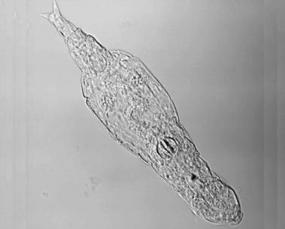 Bdelloid rotifers have acquired genes from more than 500 species including fungi, bacteria, and plants. Many of these genes confer unusual survival capabilities on the water-going microorganisms. More evdence for Horizontal Gene Transfer (HGT).
Bdelloid rotifers have acquired genes from more than 500 species including fungi, bacteria, and plants. Many of these genes confer unusual survival capabilities on the water-going microorganisms. More evdence for Horizontal Gene Transfer (HGT).
 Boschetti C, Carr A, Crisp A, Eyres I, Wang-Koh Y, et al., "Biochemical Diversification through Foreign Gene Expression in Bdelloid Rotifers" [html], doi:10.1371/journal.pgen.1003035, 8(11): e1003035, PLoS Genet, 15 Nov 2012. Boschetti C, Carr A, Crisp A, Eyres I, Wang-Koh Y, et al., "Biochemical Diversification through Foreign Gene Expression in Bdelloid Rotifers" [html], doi:10.1371/journal.pgen.1003035, 8(11): e1003035, PLoS Genet, 15 Nov 2012.
 Laura M. Zahn, "Acquiring the Essentials" [html], doi: 10.1126/science.338.6110.1010-b, p1010 v338 Science, 23 Nov 2012. Laura M. Zahn, "Acquiring the Essentials" [html], doi: 10.1126/science.338.6110.1010-b, p1010 v338 Science, 23 Nov 2012.
 Bdelloids Surviving on Borrowed DNA by Traci Watson, ScienceNow, 15 Nov 2012. Bdelloids Surviving on Borrowed DNA by Traci Watson, ScienceNow, 15 Nov 2012.
 A tenth of quirky creature's active genes are foreign, University of Cambridge, 15 Nov 2012. A tenth of quirky creature's active genes are foreign, University of Cambridge, 15 Nov 2012.
 Viruses and Other Gene Transfer Mechanisms is a related local webpage. Viruses and Other Gene Transfer Mechanisms is a related local webpage.
What'sNEW about HGT  | |
 Thanks, Ken Jopp. Thanks, Ken Jopp.
910 genes apparently transferred from prokaryotes, fungi or viruses provide essential or plant-specific activities to a well-studied species of moss, according to a team at the Key Laboratory of Biodiversity and Biogeography, Kunming Institute of Botany, Chinese Academy of Sciences. Available experimental evidence shows that these anciently acquired genes are involved in ...activities such as xylem formation, plant defence, nitrogen recycling as well as the biosynthesis of starch, polyamines, hormones and glutathione. These findings suggest that horizontal gene transfer had a critical role in the transition of plants from aquatic to terrestrial environments.
 Jipei Yue, Xiangyang Hu, Hang Sun, Yongping Yang and Jinling Huang, "Widespread impact of horizontal gene transfer on plant colonization of land" [Open Access html], doi:10.1038/ncomms2148, n1152 v3, Nature Communications, online 23 Oct 2012. Jipei Yue, Xiangyang Hu, Hang Sun, Yongping Yang and Jinling Huang, "Widespread impact of horizontal gene transfer on plant colonization of land" [Open Access html], doi:10.1038/ncomms2148, n1152 v3, Nature Communications, online 23 Oct 2012.
 Moss Harbors Foreign Genes by Ed Yong, The Scientist, 23 Oct 2012. Moss Harbors Foreign Genes by Ed Yong, The Scientist, 23 Oct 2012.
 Viruses and Other Gene Transfer Mechanisms is a related local webpage. Viruses and Other Gene Transfer Mechanisms is a related local webpage.
What'sNEW about HGT  | |
Diverse bacteriophages carry genes for proteins "targeting the eukaryotic nucleus" according to a report by a team at the Centro de Biología Molecular of the Universidad Autónoma de Madrid. These findings show a common feature of [the proteins] ...and suggest a possible common function by facilitating the horizontal transfer of genes between prokaryotes and eukaryotes. An earlier article from biologists at UCSF and UCSD elaborates on the structural role of the proteins. Bacteriophages are viruses that infect only prokaryotes, so the mere presence of these genes is surprising. Their possible role in facilitating prokaryote-eukaryote HGT should be especially jarring for darwinists.
 Modesto Redrejo-Rodríguez, Daniel Muñoz-Espín et al., "Functional eukaryotic nuclear localization signals are widespread in terminal proteins of bacteriophages" [abstract], doi:10.1073/pnas.1216635109, p18482-18487 v109, Proc. Natl. Acad. Sci. USA, 6 Nov 2012. Modesto Redrejo-Rodríguez, Daniel Muñoz-Espín et al., "Functional eukaryotic nuclear localization signals are widespread in terminal proteins of bacteriophages" [abstract], doi:10.1073/pnas.1216635109, p18482-18487 v109, Proc. Natl. Acad. Sci. USA, 6 Nov 2012.
 James A. Kraemer et al., "A Phage Tubulin Assembles Dynamic Filaments by an Atypical Mechanism to Center Viral DNA within the Host Cell" [summary], doi:10.1016/j.cell.2012.04.034, p1488-1499 v149, Cell, 22 Jun 2012. James A. Kraemer et al., "A Phage Tubulin Assembles Dynamic Filaments by an Atypical Mechanism to Center Viral DNA within the Host Cell" [summary], doi:10.1016/j.cell.2012.04.034, p1488-1499 v149, Cell, 22 Jun 2012.
 Viral Skeleton: "A newly discovered family of tubulins... encoded by bacteriophages," by Kerry Grens, The Scientist, 1 Nov 2012. Viral Skeleton: "A newly discovered family of tubulins... encoded by bacteriophages," by Kerry Grens, The Scientist, 1 Nov 2012.
 Viruses and Other Gene Transfer Mechanisms is a related local webpage. Viruses and Other Gene Transfer Mechanisms is a related local webpage.
What'sNEW about HGT  | |
 Curiosity set to weigh in on Mars methane puzzle by Eric Hand, doi:10.1038/nature.2012.11721, Nature.com, 1 Nov 2012. Curiosity set to weigh in on Mars methane puzzle by Eric Hand, doi:10.1038/nature.2012.11721, Nature.com, 1 Nov 2012.
 Curiosity finds no methane on Mars — not yet, anyway by Mike Wall, NBCNews.com, 2 Nov 2012. Curiosity finds no methane on Mars — not yet, anyway by Mike Wall, NBCNews.com, 2 Nov 2012.
 Hopes linger for Mars methane by Eric Hand, doi:10.1038/491174a, p174 v491, Nature, 8 Nov 2012. Hopes linger for Mars methane by Eric Hand, doi:10.1038/491174a, p174 v491, Nature, 8 Nov 2012.
 Richard A. Kerr, "Question of Martian Methane Is Still Up in the Air" [abstract], doi: 10.1126/science.338.6108.733, p733 v338, Science, 9 Nov 2012. Richard A. Kerr, "Question of Martian Methane Is Still Up in the Air" [abstract], doi: 10.1126/science.338.6108.733, p733 v338, Science, 9 Nov 2012.
 Life on Mars! has more about methane on Mars. Life on Mars! has more about methane on Mars.
"...A simple route to animal vision" appears in the title of a new article from biologists in Ireland and the UK. This sounds like a slam-dunk for demonstrating the power of darwinian evolution, because the authors promise to elucidate, with phylogenomics, the origin of vision. Under strictly darwiniam philosophy, all genetic programming comes from the gradual buildup of meaningful nucleotide sequences, originating on a virtually blank slate. Let's see.
 This study uses a fuller dataset than previous studies, and concludes that "only three duplications and no deletions are necessary to explain opsin evolution." The research shows that genes for opsins and melatonin receptors in metazoans can be traced to a "last opsin common ancestor (LOCA)" that apparently existed more than 700 million years ago. This LOCA subsequently underwent duplications and mutations, including an important amino acid substitution that eventually produced vision in animals.
This study uses a fuller dataset than previous studies, and concludes that "only three duplications and no deletions are necessary to explain opsin evolution." The research shows that genes for opsins and melatonin receptors in metazoans can be traced to a "last opsin common ancestor (LOCA)" that apparently existed more than 700 million years ago. This LOCA subsequently underwent duplications and mutations, including an important amino acid substitution that eventually produced vision in animals.
Orthologous genes are present even in the genomes of placozoans — microscopic eukaryotes of only about a thousand cells, with no differentiated tissues or organs of any kind. "...These opsin subfamilies must have evolved ...earlier than currently accepted. ...Our results are compatible with the view that the last common neuralian ancestor might have been more complex than generally assumed."
In our reading, no "origin" of vision is revealed here. Instead, a "last opsin common ancestor" is hypothesized to have existed already, more than 700 million years ago. The subsequent duplications, specializations and optimizations that it undewent — consistent with both cosmic ancestry and strict darwinism — are noteworthy, certainly. And the careful research uncovering the story is commendable. But how LOCA originated is not discussed. Instead, darwinism should be baffled by the early existence of the genetic programming for vision, even in primitive form, before selection pressure could affect it.
In cosmic ancestry this order of events is expected.
 Roberto Feuda et al., "Metazoan opsin evolution reveals a simple route to animal vision" [abstract], doi:10.1073/pnas.1204609109, p18868-18872 v 109 Proc. Natl. Acad. Sci. USA, 13 Nov (online 29 Oct) 2012. Roberto Feuda et al., "Metazoan opsin evolution reveals a simple route to animal vision" [abstract], doi:10.1073/pnas.1204609109, p18868-18872 v 109 Proc. Natl. Acad. Sci. USA, 13 Nov (online 29 Oct) 2012.
 New study sheds light on how and when vision evolved, University of Bristol (also PhysOrg.com), 29 Oct 2012. New study sheds light on how and when vision evolved, University of Bristol (also PhysOrg.com), 29 Oct 2012.
 Metazoan Genes Older Than Metazoa? is a related local webpage. Metazoan Genes Older Than Metazoa? is a related local webpage.
 Genes Older Than Earth? is a possibly related local webpage. Genes Older Than Earth? is a possibly related local webpage.
 Thanks for alerting us, Stan Franklin. Thanks for alerting us, Stan Franklin.
Evolution by subfunctionalization has been stimulated and observed by a team at UC Davis and Uppsala University, Sweden. In subfunctionalization, a gene that has two functions becomes duplicated, and each copy specializes in one of the original functions. In this quarantined experiment using Salmonella enterica, and in most natural examples, one of the two functions was formerly inactive.
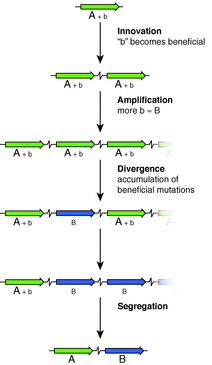 "The bacteria carried a gene involved in making the amino acid histidine that had a secondary, weak ability to contribute to the synthesis of another amino acid, tryptophan. In their study, they removed the main tryptophan-synthesis gene from the bacteria.... After growing the bacteria for 3,000 generations on a culture medium without tryptophan, ...[w]hat emerged was a tryptophan-synthesizing activity provided by a duplicated copy of the original gene."
"The bacteria carried a gene involved in making the amino acid histidine that had a secondary, weak ability to contribute to the synthesis of another amino acid, tryptophan. In their study, they removed the main tryptophan-synthesis gene from the bacteria.... After growing the bacteria for 3,000 generations on a culture medium without tryptophan, ...[w]hat emerged was a tryptophan-synthesizing activity provided by a duplicated copy of the original gene."
That gene came under ongoing selective pressure after the removal of another gene previously doing the job. The experimenters reason that this immediate pressure prevented random mutations from disabling the needed function, and instead, optimized it. This team is another one doing experiments in quarantined biological systems, which experiments we wholly endorse.
The research does not discover a "new" function but an existing, previously silent function. This example adds to many others in which an existing program sits unused within a genome, ready and waiting for circumstances and selective pressure to promote it into service. These examples are surprising for darwinism, but they confirm a basic prediction of cosmic ancestry.
 Joakim Näsvall et al., "Real-Time Evolution of New Genes by Innovation, Amplification, and Divergence"
[abstract], doi:10.1126/science.1226521, p384-387 v338, Science, 19 Oct 2012. Joakim Näsvall et al., "Real-Time Evolution of New Genes by Innovation, Amplification, and Divergence"
[abstract], doi:10.1126/science.1226521, p384-387 v338, Science, 19 Oct 2012.
 Elizabeth Pennisi, "Gene Duplication's Role in Evolution Gets Richer, More Complex" [summary], doi:10.1126/science.338.6105.316, p316-317 v338, Science, 19 Oct 2012. Elizabeth Pennisi, "Gene Duplication's Role in Evolution Gets Richer, More Complex" [summary], doi:10.1126/science.338.6105.316, p316-317 v338, Science, 19 Oct 2012.
 Evolution of new genes captured, UC Davis News Service (also PhysOrg.com), 19 Oct 2012. Evolution of new genes captured, UC Davis News Service (also PhysOrg.com), 19 Oct 2012.
 Duplication Makes A New Primate Gene is a related local webpage. Duplication Makes A New Primate Gene is a related local webpage.
 New genetic programs in Darwinism and strong panspermia is a related local webpage. New genetic programs in Darwinism and strong panspermia is a related local webpage.
 ...De Novo Genes is a related local webpage. ...De Novo Genes is a related local webpage.
 Gene duplication is the primary source of new genes has more about subfunctionalization, What'sNEW, 27 Jun 2005. Gene duplication is the primary source of new genes has more about subfunctionalization, What'sNEW, 27 Jun 2005.
 New genetic functions arise when selection is imposed on a minor side function of a preexisting gene, What'sNEW, 20 Oct 2007 New genetic functions arise when selection is imposed on a minor side function of a preexisting gene, What'sNEW, 20 Oct 2007
 ...Aerobic citrate metabolism among cloned bacteria, about another unused program, What'sNEW, 20 Sep 2012. ...Aerobic citrate metabolism among cloned bacteria, about another unused program, What'sNEW, 20 Sep 2012.
 Thanks, Jerry Chancellor. Thanks, Jerry Chancellor.
Richard Hoover, in responses to Caleb Scharf's Scientific American posting of four days ago, requests a review of the evidence for fossilized microbes in carbonaceous meteorites. Scharf (pictured) is the director of Columbia University's multidisciplinary Astrobiology Center. He ought to be qualified to recognize fossilized microbial life and to consider evidence thereof in meteorites. But Scharf writes, "I'd disagree that there's any good evidence in meteoritic material at the moment - all such claims are highly controversial." Hoover asks, in effect, What exactly is the controversy about? It doesn't seem to be about the evidence. In two blog entries, Hoover succinctly reviews the case and invites any serious counter-argument.
 The Panspermia Paradox by Caleb A. Scharf, posted on Scientific American, 15 Oct 2012. The Panspermia Paradox by Caleb A. Scharf, posted on Scientific American, 15 Oct 2012.
 ...I have provided solid evidence..., 16 Oct, and Science is based on evidence..., 18 Oct 2012, Hoover's entries. ...I have provided solid evidence..., 16 Oct, and Science is based on evidence..., 18 Oct 2012, Hoover's entries.
 Fossilized bacteria in meteorites are obvious, the related What'sNEW article about Hoover's evidence, with links, 3 Mar 2011.
Caleb Scharf answers Richard Hoover, "asking about how one establishes the *precise* effect of atmospheric entry [etc.]" He is casting doubt on the evidence for fossilized microbes in carbonaceous meteorites like Orgueil. But for his to be a valid criticism, Scharf must suppose that a few seconds of atmospheric entry could somehow affect the meteorite such that subsequent earthly contaminants, within the next century-and-a half, would lose all of their nitrogen and phosphorus, and half of their amino acids, while the others became well racemized. These processes take tens of thousands to millions of years in all known cases. Atmospheric entry could cause all of these — and only these — processes to accelerate by orders of magnitude? We had not heard this suggestion before now. Scharf concludes that no meteorite reaching earth could offer convincing evidence. To us, he seems too eager to dismiss the striking evidence already on hand. In this respect he is not unusual. Very frustrating. Fossilized bacteria in meteorites are obvious, the related What'sNEW article about Hoover's evidence, with links, 3 Mar 2011.
Caleb Scharf answers Richard Hoover, "asking about how one establishes the *precise* effect of atmospheric entry [etc.]" He is casting doubt on the evidence for fossilized microbes in carbonaceous meteorites like Orgueil. But for his to be a valid criticism, Scharf must suppose that a few seconds of atmospheric entry could somehow affect the meteorite such that subsequent earthly contaminants, within the next century-and-a half, would lose all of their nitrogen and phosphorus, and half of their amino acids, while the others became well racemized. These processes take tens of thousands to millions of years in all known cases. Atmospheric entry could cause all of these — and only these — processes to accelerate by orders of magnitude? We had not heard this suggestion before now. Scharf concludes that no meteorite reaching earth could offer convincing evidence. To us, he seems too eager to dismiss the striking evidence already on hand. In this respect he is not unusual. Very frustrating.
 By way of a coda to all these comments... by Caleb A. Scharf, 21 Oct 2012. By way of a coda to all these comments... by Caleb A. Scharf, 21 Oct 2012.
 You are a physicist and obviously out of your element, Richard Hoover responds, 6 Jan 2013. You are a physicist and obviously out of your element, Richard Hoover responds, 6 Jan 2013.
 For many years I have been following the Panspermia theory, Bill Smith responds, 16 May 2013. For many years I have been following the Panspermia theory, Bill Smith responds, 16 May 2013.
 Could Martian Bacteria Have Seeded Earth? by Jeffrey Kluger, TIME Science & Space, 11 Oct 2012. Could Martian Bacteria Have Seeded Earth? by Jeffrey Kluger, TIME Science & Space, 11 Oct 2012.
 Life on Mars! is a related local webpage. Life on Mars! is a related local webpage.
 ....If life arose on Earth shortly after surface water was available, there were possibly about 400 million years when life could have journeyed from Earth to another habitable world, and vice versa.... If life had an early start in other planetary systems and developed before the sun's birth cluster dispersed, life on Earth may have originated beyond our solar system.
....If life arose on Earth shortly after surface water was available, there were possibly about 400 million years when life could have journeyed from Earth to another habitable world, and vice versa.... If life had an early start in other planetary systems and developed before the sun's birth cluster dispersed, life on Earth may have originated beyond our solar system.
 Edward Belbruno, Amaya Moro-Martín, Renu Malhotra, and Dmitry Savransky, "Chaotic Exchange of Solid Material Between Planetary Systems: Implications for Lithopanspermia" [abstract], doi:10.1089/ast.2012.0825, p754-774 v12 n8, Astrobiology, 12 Sep 2012. Edward Belbruno, Amaya Moro-Martín, Renu Malhotra, and Dmitry Savransky, "Chaotic Exchange of Solid Material Between Planetary Systems: Implications for Lithopanspermia" [abstract], doi:10.1089/ast.2012.0825, p754-774 v12 n8, Astrobiology, 12 Sep 2012.
 Slow-moving rocks better odds that life crashed to earth from space by Morgan Kelly, News at Princeton (also ScienceDaily, PhysOrg.com and Astrobiology Magazine), 24 Sep 2012. Slow-moving rocks better odds that life crashed to earth from space by Morgan Kelly, News at Princeton (also ScienceDaily, PhysOrg.com and Astrobiology Magazine), 24 Sep 2012.
 More Evidence That Life Was Delivered By Space Rocks by Lee Rannals, redOrbit.com, 24 Sep 2012. More Evidence That Life Was Delivered By Space Rocks by Lee Rannals, redOrbit.com, 24 Sep 2012.
 Did a Distant Solar System Send Life to Earth? by Jeffrey Kluger, TIME Science & Space, 26 Sep 2012. Did a Distant Solar System Send Life to Earth? by Jeffrey Kluger, TIME Science & Space, 26 Sep 2012.
 Did Slow Space Rocks Seed Life on Earth? by Luna Shyr, National Geographic News, 28 Sep 2012. Did Slow Space Rocks Seed Life on Earth? by Luna Shyr, National Geographic News, 28 Sep 2012.
 Cardiff professor's wacky idea of alien life on Earth wins backing at Princeton by Brendan Hughes, WalesOnline, 30 Sep 2012. Cardiff professor's wacky idea of alien life on Earth wins backing at Princeton by Brendan Hughes, WalesOnline, 30 Sep 2012.
 Panspermia Asks New Questions describes lithopanspermia (by several names) and other versions of panspermia. Panspermia Asks New Questions describes lithopanspermia (by several names) and other versions of panspermia.
 Introduction: More Than Panspermia is a related local webpage. Introduction: More Than Panspermia is a related local webpage.
 Thanks, Larry Klaes, Rob Sheldon, Ken Jopp, Stan Franklin, Jeanne Jemison, Yogesh Shouche, Google Alerts and Robert Cobb. Thanks, Larry Klaes, Rob Sheldon, Ken Jopp, Stan Franklin, Jeanne Jemison, Yogesh Shouche, Google Alerts and Robert Cobb.
|
 Evolution: A View from the 21st Century by James A. Shapiro is our new favorite book. The author writes from a challenging perspective gained from a thorough study of the variety of processes that manipulate genomes. These include, for example, DNA formatting, DNA proofreading and repair, and epigenetic regulation. He agrees that horizontal gene transfer (HGT) is important, although Shapiro deems "gene" an imprecise term and avoids it. Hence, Horizontal DNA Transfer. And he writes, ...Viruses serve as sources of novelties that can later be adapted by cells (p 133).
Evolution: A View from the 21st Century by James A. Shapiro is our new favorite book. The author writes from a challenging perspective gained from a thorough study of the variety of processes that manipulate genomes. These include, for example, DNA formatting, DNA proofreading and repair, and epigenetic regulation. He agrees that horizontal gene transfer (HGT) is important, although Shapiro deems "gene" an imprecise term and avoids it. Hence, Horizontal DNA Transfer. And he writes, ...Viruses serve as sources of novelties that can later be adapted by cells (p 133).

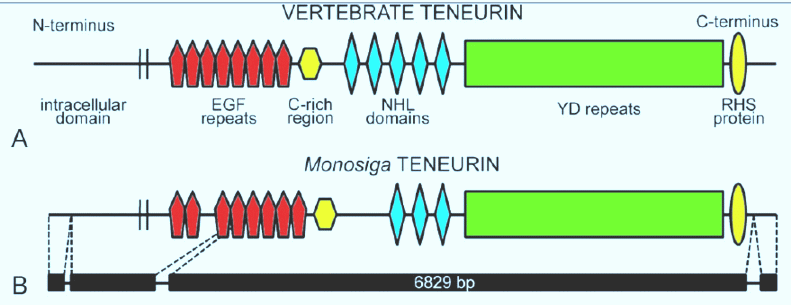
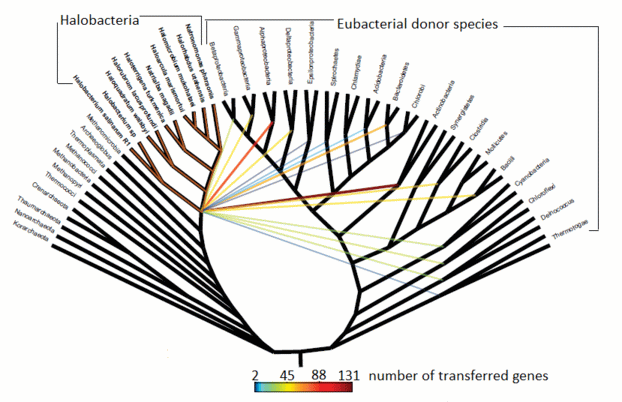
 Life does fine in sub-zero brine locked under ice for millenia. Diverse microbes collected in salty, mineral rich Lake Vida in Antarctica were metabolically active, although isotope analysis indicates that the lake has been covered with ice for 2,800 years. The discovery of this ecosystem and the in situ biotic and abiotic processes occurring at low temperature ...is a potential analog for habitats on other icy worlds where water-rock reactions may cooccur with saline deposits and subsurface oceans. We are awaiting analysis from deeper, longer-isolated Antarctic lakes, like Vostok.
Life does fine in sub-zero brine locked under ice for millenia. Diverse microbes collected in salty, mineral rich Lake Vida in Antarctica were metabolically active, although isotope analysis indicates that the lake has been covered with ice for 2,800 years. The discovery of this ecosystem and the in situ biotic and abiotic processes occurring at low temperature ...is a potential analog for habitats on other icy worlds where water-rock reactions may cooccur with saline deposits and subsurface oceans. We are awaiting analysis from deeper, longer-isolated Antarctic lakes, like Vostok. Bdelloid rotifers have acquired genes from more than 500 species including fungi, bacteria, and plants. Many of these genes confer unusual survival capabilities on the water-going microorganisms. More evdence for Horizontal Gene Transfer (HGT).
Bdelloid rotifers have acquired genes from more than 500 species including fungi, bacteria, and plants. Many of these genes confer unusual survival capabilities on the water-going microorganisms. More evdence for Horizontal Gene Transfer (HGT).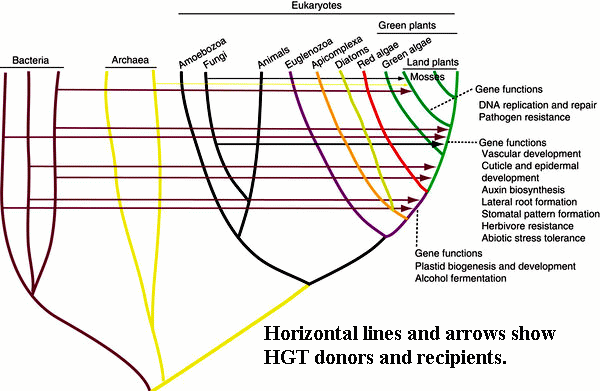



 The regulatory sequences are micro RNAs (miRNA), short (20–24 nucleotide) single-stranded RNAs. In mammals, they form stable hairpin structures. These can, with the participation of special enzymes, control the expression of other genes, with profound effects.
The regulatory sequences are micro RNAs (miRNA), short (20–24 nucleotide) single-stranded RNAs. In mammals, they form stable hairpin structures. These can, with the participation of special enzymes, control the expression of other genes, with profound effects.
 This study uses a fuller dataset than previous studies, and concludes that "only three duplications and no deletions are necessary to explain opsin evolution." The research shows that genes for opsins and melatonin receptors in metazoans can be traced to a "last opsin common ancestor (LOCA)" that apparently existed more than 700 million years ago. This LOCA subsequently underwent duplications and mutations, including an important amino acid substitution that eventually produced vision in animals.
This study uses a fuller dataset than previous studies, and concludes that "only three duplications and no deletions are necessary to explain opsin evolution." The research shows that genes for opsins and melatonin receptors in metazoans can be traced to a "last opsin common ancestor (LOCA)" that apparently existed more than 700 million years ago. This LOCA subsequently underwent duplications and mutations, including an important amino acid substitution that eventually produced vision in animals.
 "The bacteria carried a gene involved in making the amino acid histidine that had a secondary, weak ability to contribute to the synthesis of another amino acid, tryptophan. In their study, they removed the main tryptophan-synthesis gene from the bacteria.... After growing the bacteria for 3,000 generations on a culture medium without tryptophan, ...[w]hat emerged was a tryptophan-synthesizing activity provided by a duplicated copy of the original gene."
"The bacteria carried a gene involved in making the amino acid histidine that had a secondary, weak ability to contribute to the synthesis of another amino acid, tryptophan. In their study, they removed the main tryptophan-synthesis gene from the bacteria.... After growing the bacteria for 3,000 generations on a culture medium without tryptophan, ...[w]hat emerged was a tryptophan-synthesizing activity provided by a duplicated copy of the original gene."